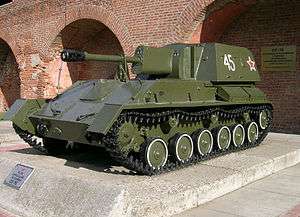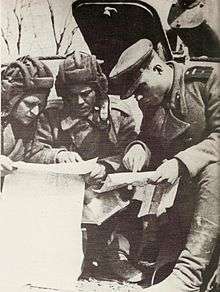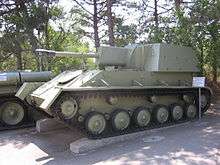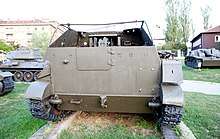SU-76
The SU-76 (Samokhodnaya Ustanovka 76) was a Soviet self-propelled gun used during and after World War II. The SU-76 was based on a lengthened and widened version of the T-70 light tank chassis. Its simple construction made it the second most produced Soviet armoured vehicle of World War II, after the T-34 tank.
| SU-76M | |
|---|---|
 SU-76M self-propelled gun in the Memorial Complex in honor of Nizhny Novgorod citizens who died in World War II, Nizhny Novgorod Kremlin, Russia | |
| Type | Self-propelled gun |
| Place of origin | |
| Production history | |
| Designer | S.A. Ginzburg Design Bureau |
| Designed | 1942 |
| Manufacturer | Plant No.38 (Kirov, Kirov Oblast), Plant No.40 (Mytishchi), GAZ (Gorky) |
| Produced | November 1942 – November 1945 |
| No. built | 14,292 (560 SU-76 & 13,732 SU-76M)[1] |
| Specifications | |
| Mass | 10,500 kg (23,148 lb) |
| Length | 4.97 m (16 ft 3.6 in) |
| Width | 2.71 m (8 ft 10.7 in) |
| Height | 2.10 m (6 ft 10.7 in) |
| Crew | 4 |
| Armor | Front: 35 mm (1.4 in) Side: 15 mm (0.59 in) |
Main armament | 76.2 mm (2.99 in) ZIS-3 gun |
Secondary armament | 7.62 mm (0.299 in) DT machine gun |
| Engine | 2× GAZ-203 6-cylinder gasoline engines 2× 70 hp (51.5 + 51.5 kW) |
| Power/weight | 13.3 hp/tonne |
| Suspension | torsion bar |
| Fuel capacity | 412 liters |
Operational range | 320 km (199 miles) |
| Maximum speed | 44 km/h (27.3 mph) |
Crews liked the vehicle for its simplicity, reliability, and ease of use. However, the steering was also sometimes regarded as difficult, leading crews to also refer to the vehicle as suka (Russian: сука; "bitch") or suchka (Russian: сучка; "little bitch"). It was also nicknamed Golozhopiy Ferdinand (Russian: Голожопый Фердинанд; "bare-arsed Ferdinand") due to its very light armor and somewhat similar silhouette, when compared to the Germans' heavy Ferdinand/Elefant casemate tank destroyer of some 65 tonnes in weight.
History
Design of the SU-76 began in November 1942, when the State Defense Committee ordered the construction of infantry support self-propelled guns armed with the ZiS-3 76.2 mm anti-tank gun and the M-30 122 mm howitzer. The T-70 chassis was chosen for mounting the ZiS-3 gun, and was lengthened, adding one road wheel per side, to facilitate better gun mounting. The vehicle was not completely enclosed by armour, the rear roof and upper rear side exposed.
The power-plant setup installed in the first mass-produced SU-76s was unreliable. Two GAZ-202 automobile engines were used mounted in "parallel", each engine driving one track. It was found to be difficult for the driver to control the two engines simultaneously, and strong vibration forces led to early failures of engines and transmission units. After 560 SU-76s had been made, mass production was halted in order to resolve the problems. Two chief designers at the GAZ plant, N. A. Astrov and A. A. Lipgart, changed the power-plant arrangement to that of the T-70 - the two engines were mounted in tandem on the right hand side of the vehicle. The armoured roof over the gun compartment was removed to improve access to and servicing of the weapon. This modified version, called the SU-76M, was placed in mass production in early 1943.
After production resumed, GAZ and two factories in Kirov and Mytishchi produced 13,732 SU-76Ms; over 9,000 of the vehicles were built solely by GAZ. Mass production of the SU-76M ceased in the second half of 1945. In contemporary accounts SU-76Ms are often referred to in texts, public radio and TV broadcasting as SU-76s with the "M" omitted, due to their ubiquity in comparison with the original SU-76s.[2]
The SU-76 was the basis for the first Soviet tracked armoured anti-aircraft vehicle, the ZSU-37. Mass production of the ZSU-37 was continued after SU-76M production ceased. All SU-76Ms had been withdrawn from front-line service shortly after the war ended, although some were retained as training vehicles for T-34 crews as late as 1955.[3]
Variants
- OSU-76
- Experimental model based on the T-60 tank chassis.
- SU-76
- Based on a lengthened T-70 tank chassis, with the inferior dual-engine arrangement of earlier T-70s. Only 560 were produced, and these were quickly withdrawn from front line service.
- SU-76M
- Main production model.
- SU-76B
- Featured a completely enclosed armoured crew compartment. Only a few were produced.
- ZSU-37
- Self-propelled anti-aircraft gun, based on the SU-76.
The unrelated SU-76i (the "i" standing for "Inostrannaya", or "Foreign" in Russian), first designed and fielded in 1943, was based on captured stocks of German Panzer III and StuG III chassis, a large quantity coming from defeated German troops after the Battle of Stalingrad that year. This partially-modified vehicle was armed with a S-1 76.2 mm tank gun (a cheaper variant of the renowned F-34/ZiS-5 guns which were already mounted on T-34 and KV-1 tanks respectively) in a casemate superstructure but retained the original German Maybach gasoline engine and its torsion-bar suspension system. Around 200 of these ex-German vehicles were sent for conversion into SU-76is at Factory No. 37 to supplement the existing SU-76. They were issued to tank and self-propelled gun units starting in the fall of 1943.[4] They were eventually withdrawn from the front in early 1944 and then used for training and testing until the end of 1945.[5] Only 2 have survived the war, most having been scrapped after 1945.
The also unrelated SU-76P (1941) was based on the T-26 chassis. it was built in Leningrad during the Siege of Leningrad and involved removing the turret from the T-26 and mounting a 76 mm regimental gun M1927 on the engine deck. This was created due to the lack of high explosive 45mm ammunition inside Leningrad due to the siege, so some T-26 tanks were rearmed with 37mm or 76mm guns for which a reliable source of ammunition was available. They served until 1944, when the siege was broken. They were originally called SU-76, until the SU-76 came into service, upon which it was renamed SU-76P ("polkovaya" - regimental).[6]
In 1978, Institute 111 from Romania designed an armoured personnel carrier based on the SU-76 chassis, equipped with the TAB-71 turret. The vehicle entered service as the MLVM (Romanian: Mașina de Luptă a Vânătorilor de Munte, meaning "infantry fighting vehicle of vânători de munte").
Combat history

The SU-76M virtually replaced infantry tanks in the close support role. While its thin armour and open top made it vulnerable to antitank weapons, grenades, and small arms, its light weight and low ground pressure gave it good mobility.
The SU-76M combined three main battlefield roles: light assault gun, mobile anti-tank weapon and mobile gun for indirect fire. As a light assault gun, the SU-76M was well-regarded by Soviet infantrymen (in contrast with their own crews). It had more powerful weapons than any previous light tank for close support and communication between infantry and the SU-76M crew was simple due to the open crew compartment. This was extremely useful in urban combat where good teamwork between infantry and AFVs was a key to success. Although the open compartment was highly vulnerable to small arms fire and hand grenades, it very often saved the crew's lives in the case of a hit by a Panzerfaust, whose concussion blast would mean death in an enclosed vehicle.
The SU-76M was effective against any medium or light German tank. It could also knock out the Panther tank with a flank shot, but the ZiS-3 gun was not effective against Tiger tanks. Soviet manuals for SU-76M crews usually instructed the gunner to aim for the tracks or gun barrels when facing Tigers. To improve the SU-76M's anti-armour capabilities, armour-piercing composite rigid (APCR) and hollow charge projectiles were introduced. This gave the SU-76M a better chance against heavily armoured German vehicles. A low profile, a low noise signature and good mobility were other advantages of the SU-76M. This was ideal for organizing ambushes and sudden flank or rear strikes in close combat, where the ZiS-3 gun was sufficient against most German armoured fighting vehicles.
The maximum elevation angle of the ZiS-3 was the highest of all Soviet self-propelled guns. The maximum indirect fire distance was nearly 17 km. SU-76Ms were sometimes used as light artillery vehicles (like the German Wespe) for bombardments and indirect fire support. However the power of the 76.2 mm shells was not sufficient in many cases.
The SU-76M was the single Soviet vehicle able to operate in swamps with minimal support from engineers. During the Belarus liberation campaign in 1944 it was extremely useful for organizing surprise attacks through swamps; bypassing heavy German defenses on firmer ground. Usually only lightly armed infantry could pass through large swampy areas. With SU-76M support, Soviet soldiers and engineers could effectively destroy enemy strongpoints and continue to advance.

The SU-76M had a large number of ammunition types. They included armour-piercing (usual, with ballistic nose and subcaliber hyper-velocity), hollow charge, high explosive, fragmentation, shrapnel and incendiary projectiles. This made the SU-76M an excellent multi-purpose light armoured fighting vehicle.
One famous crewman was Rem Nikolaevich Ulanov. In his younger days he was a mechanic-driver and later a commander of a SU-76. He and some other soldiers called their SU-76 Columbina after the female Renaissance Italian Commedia dell'Arte personage.
After World War II, the SU-76 was used by Communist forces in the Korean War. A small number of SU-76Ms were captured and used by South Korea after the landing at Incheon.
Operators




.svg.png)
.svg.png)
Surviving examples
Due to the large number of vehicles produced, many SU-76Ms have survived the post-war years, and most of the larger Russian military museums have examples of the SU-76M in their exhibitions. They can also be found at the German-Soviet War monuments or memorials in different Russian, Belarusian, and Ukrainian cities.
In museums



- Australia
- The Australian Armour and Artillery Museum (Cairns) SU-76M
- Bulgaria
- National Museum of Military History, Sofia.
- Poland
- Muzeum Oręża Polskiego in Kołobrzeg - SU-76
- Armoured Weapon Museum in Poznań - SU-76M
- Polish Army Museum in Warsaw
- exhibition in front of the main building - SU-76 tactical number 203, serial number 403062
- Museum of Polish Military Technology - SU-76 tactical number 207
- Romania
- Russia
- Central Armed Forces Museum in Moscow
- Technical Museum of Vadim Zadorozhny in Krasnogorsky District, Moscow Oblast - in running condition
- Kubinka Tank Museum in Kubinka, Moscow Oblast
- Museum of Military History in Padikovo, Istrinsky District, Moscow Oblast - in running condition
- Military Historical Museum of Artillery, Engineers and Signal Corps in Saint Petersburg
- Mount Sapun Memorial Complex in Sevastopol
- United Kingdom
- The Tank Museum in Bovington - SU-76M captured from North Korea in 1950[12]
See also
- List of Soviet tanks
References
- Chubachin 2009, p. 29.
- Charles C. Sharp, "Red Hammers", Soviet Self-Propelled Artillery and Lend Lease Armor 1941 - 1945, Soviet Order of Battle World War II, vol. XII, Nafziger, 1998, p 8
- Central Intelligence Agency Information Report
- Zaloga 1984, p 180.
- http://english.battlefield.ru/tanks/11-spg/32-su-76i.html
- "SOVIET SPs 1941-1945, Light SPs, M.Svirin". df.ru.
- Bishop, Chris (1998). The Encyclopedia of Weapons of World War II. New York: Metro Books, Friedman/Fairfax Publishers. p. 118. ISBN 978-0760710227.
- "Trade Registers". Armstrade.sipri.org. Retrieved 20 June 2013.
- "Intelligence Memorandum: Communist Military Aid Deliveries to North Vietnam during 1968" (PDF). Langley: Central Intelligence Agency. May 1969. Archived from the original (PDF) on 23 January 2017. Retrieved 20 May 2017.
- Tucker, Spencer C. (2011). The Encyclopedia of the Vietnam War: A Political, Social, and Military History (2nd ed.). Santa Barbara, California: ABC-CLIO. p. 1088. ISBN 9781851099603.
- Kočevar, Iztok (August 2014). "Micmac à tire-larigot chez Tito: L'arme blindée yougoslave durant la Guerre froide" [The Yugoslav armored arm during the Cold War]. Batailles et Blindés (in French). No. 62. Caraktère. pp. 66–79. ISSN 1765-0828.
- Museum Accession Record
Further reading
- Zaloga, Steven J., James Grandsen (1984). Soviet Tanks and Combat Vehicles of World War Two, London: Arms and Armour Press. ISBN 0-85368-606-8.
- Dougherty, Martin J. (2008). Tanks; From World War I to the Present Day, New York: Metro Books. ISBN 1-4351-0123-5
- Чубачин, А.В. СУ-76. "Братская могила экипажа" или оружие Победы? Москва: БТВ-Книга, Яуза, ЭКСМО, 2009. Chubachin, A.V. SU-76. "Bratskaya mogila ekipazha" ili oruzhie Pobedy? (SU-76. "The Mass Grave of the Crew" or Weapons of Victory?). Moscow, Russia: BTV-Kniga, Yauza, EKSMO, 2009. ISBN 978-5-699-32965-6.
External links
| Wikimedia Commons has media related to SU-76. |
- Axis History Factbook
- Su-76 and SU-76i at Battlefield.ru
- LemaireSoft
- OnWar
- WWII Vehicles
- Interview with an SU-76 gunner